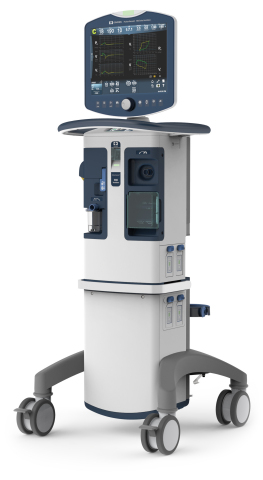
Puritan Bennett(TM) 980 ventilator (Photo: Business Wire)
The new acute care ventilator from Covidien—designed to be simple, safe and smart—helps enable patients to breathe more naturally† through some of the most innovative breath technology available.
The most critical goal of clinicians is to get patients off mechanical ventilation as soon as possible. The Puritan Bennett 980 ventilator can help with a range of software capabilities, including Proportional Assist™* Ventilation Plus (PAV™*+) and Leak Sync software. Proportional Assist™* Ventilation Plus (PAV™*+) has been shown to help reduce asynchrony, 1-3 which studies have shown may reduce days on mechanical ventilation.4-6
“We believe mechanical ventilation should be natural enough to enable patients to breathe on their own more quickly,” said
Patients on mechanical ventilation are often sedated to ease agitation and help them tolerate breath support and other medical interventions.7 The Puritan Bennett 980 ventilator features advanced synchrony tools that help clinicians set the ventilator to adapt to their patients’ unique needs and help provide the appropriate level of support throughout the breath.
The Puritan Bennett 980 ventilator system is for patients ranging from neonatal to adult. The ventilator system was also approved for commercial distribution in
For more information about the Puritan Bennett 980 ventilator, please visit www.covidien.com/PB980.
†Compared to conventional mechanical ventilation
* Proportional Assist and PAV are registered trademarks of
References
1. Xirouchaki N, Kondili E, Vaporidi K, et al. Proportional assist ventilation with load-adjustable gain factors in critically ill patients: comparison with pressure support. Intensive Care Med. 2008;34(11):2026-2034.
2. Xirouchaki N, Kondili E, Klimathianaki M, Georgopoulos D. Is proportional-assist ventilation with load-adjustable gain factors a user-friendly mode? Intensive Care Med. 2009;35(9):1599-1603.
3. Costa R, Spinazzola G, Cipriani F, et al. A physiologic comparison of proportional assist ventilation with load-adjustable gain factors (PAV+) versus pressure support ventilation (PSV). Intensive Care Med. 2011;37(9):1494-1500.
4. Thille AW, Rodriguez P, Cabello B, Lellouche F, Brochard L. Patient-ventilator asynchrony during assisted mechanical ventilation. Intensive Care Med. 2006;32(10):1515-1522.
5. de Wit M, Miller KB, Green DA, Ostman HE, Gennings C, Epstein SK: Ineffective triggering predicts increased duration of mechanical ventilation. Crit Care Med. 2009;37(10):2740-2745.
6. Epstein SK. Optimizing patient-ventilator synchrony. Semin Respir Crit Care Med. 2001;22(2):137-152.
7. Siegel MD. Management of agitation in the intensive care unit. Clin Chest Med. 2003;24(4):713-725.
ABOUT
Photos/Multimedia Gallery Available: http://www.businesswire.com/multimedia/home/20140226006778/en/
Source:
Covidien
Rhonda Luniak, 303-406-8743
Vice President
R&MS Communications
rhonda.luniak@covidien.com
or
Lisa Clemence, 508-452-4375
Director
Corporate Communications
lisa.clemence@covidien.com
or
Coleman Lannum, CFA, 508-452-4343
Vice President
Investor Relations
cole.lannum@covidien.com
or
Todd Carpenter, 508-452-4363
Senior Director
Investor Relations
todd.carpenter@covidien.com
